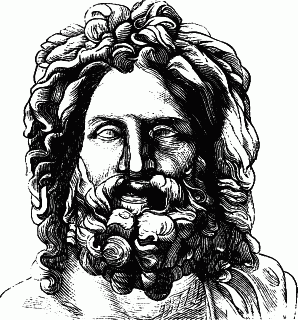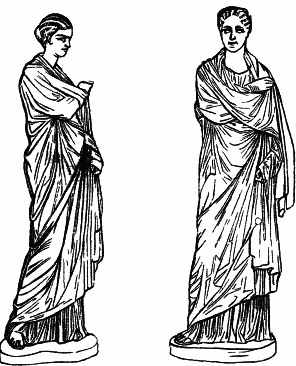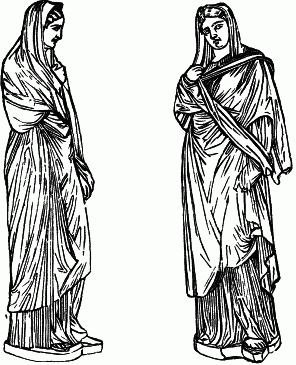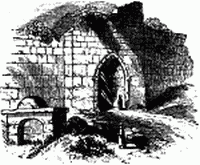
So far as true history can guess, the Romans really did have kings and drove them out, but there are signs that, though Porsena was a real king, the war was not so honorable to the Romans as they said, for he took the city and made them give up all their weapons to him, leaving them nothing but their tools for husbandry. But they liked to forget their misfortunes.
The older Roman families were called patricians, or fathers, and thought all rights to govern belonged to them. Settlers who came in later were called plebeians, or the people, and at first had no rights at all, for all the land belonged to the patricians, and the only way for the plebeians to get anything done for them was to become hangers-on—or, as they called it, clients—of some patrician who took care of their interests. There was a council of patricians called the Senate, chosen among themselves, and also containing by right all who had been chief magistrates. The whole assembly of the patricians was called the Comitia. They, as has been said before, fought on horseback, while the plebeians fought on foot; but out of the rich plebeians a body was formed called the knights, who also used horses, and wore gold rings like the patricians.

But the plebeians were always trying not to be left out of everything. By and by, they said under Servius Tullius, the city was divided into six quarters, and all the families living in them into six tribes, each of which had a tribune to watch over it, bring up the number of its men, and lead them to battle. Another division of the citizens, both patrician and plebeian, was made every five years. They were all counted and numbered and divided off into centuries according to their wealth. Then these centuries, or hundreds, had votes, by the persons they chose, when it was a question of peace or war. Their meeting was called the Comitia; but as there were more patrician centuries than plebeian ones, the patricians still had much more power. Besides, the Senate and all the magistrates were in those days always patricians. These magistrates were chosen every year. There were two consuls, who were like kings for the time, only that they wore no crowns; they had purple robes, and sat in chairs ornamented with ivory, and they were always attended by lictors, who carried bundles of rods tied round an axe—the first for scourging, the second for beheading. There were under them two prætors, or judges, who tried offences; two quæstors, who attended to the public buildings; and two censors, who had to look after the numbering and registering of the people in their tribes and centuries. The consuls in general commanded the army, but sometimes, when there was a great need, one single leader was chosen and was called dictator. Sometimes a dictator was chosen merely to fulfil an omen, by driving a nail into the head of the great statue of Jupiter in the Capitol. Besides these, all the priests had to be patricians; the chief of all was called Pontifex Maximus. Some say this was because he was the fax (maker) of pontes (bridges), as he blessed them and decided by omens where they should be; but others think the word was Pompifex, and that he was the maker of pomps or ceremonies. There were many priests as well as augurs, who had to draw omens from the flight of birds or the appearance of sacrifices, and who kept the account of the calendar of lucky and unlucky days, and of festivals.

The Romans were a grave religious people in those days, and did not count their lives or their affections dear in comparison with their duties to their altars and their hearths, though their notions of duty do not always agree with ours. Their dress in the city was a white woollen garment edged with purple—it must have been more like in shape to a Scottish plaid than anything else—and was wrapped round so as to leave one arm free: sometimes a fold was drawn over the head. No one might wear it but a free-born Roman, and he never went out on public business without it, even when more convenient fashions had been copied from Greece. Those who were asking votes for a public office wore it white (candidus), and therefore were called candidates. The consuls had it on great days entirely purple and embroidered, and all senators and ex-magistrates had broader borders of purple. The ladies wore a long graceful wrapping-gown; the boys a short tunic, and round their necks was hung a hollow golden ball called a bulla, or bubble. When a boy was seventeen, there was a great family sacrifice to the Lares and the forefathers, his bulla was taken off, the toga was put on, and he was enrolled by his own prænomen, Caius or Lucius, or whatever it might be, for there was only a choice of fifteen. After this he was liable to be called out to fight. A certain number of men were chosen from each tribe by the tribune. It was divided into centuries, each led by a centurion; and the whole body together was called a legion, from lego, to choose. In later times the proper number for a legion was 6000 men. Each legion had a standard, a bar across the top of the spear, with the letters on it S P Q R—Senatus, Populus Que Romanus—meaning the Roman Senate and People, a purple flag below and a figure above, such as an eagle, or the wolf and twins, or some emblem dear to the Romans. The legions were on foot, but the troops of patricians and knights on horseback were attached to them and had to protect them.

The Romans had in those days very small riches, they held in general small farms in the country, which they worked themselves with the help of their sons and slaves. The plebeians were often the richest. They too held farms leased to them by the state, and had often small shops in Rome. The whole territory was so small that it was easy to come into Rome to worship, attend the Senate, or vote, and many had no houses in the city. Each man was married with a ring and sacrifice, and the lady was then carried over the threshold, on which a sheepskin was spread, and made mistress of the house by being bidden to be Caia to Caius. The Roman matrons were good and noble women in those days, and the highest praise of them was held to be Domum mansit, lanam fecit—she stayed at home and spun wool. Each man was absolute master in his own house, and had full power over his grown-up sons, even for life or death, and they almost always submitted entirely. For what made the Romans so great was that they were not only brave, but they were perfectly obedient, and obeyed as perfectly as they could their fathers, their officers, their magistrates, and, as they thought, their gods.
